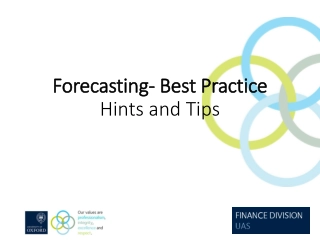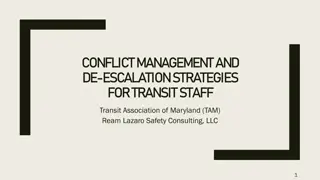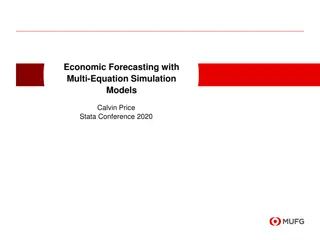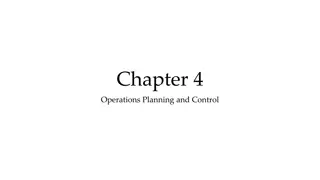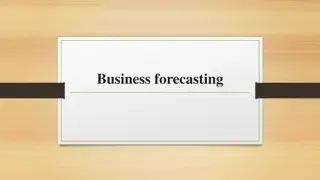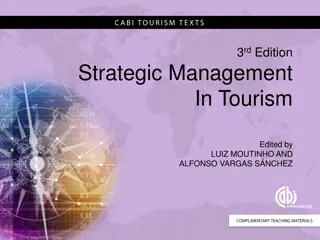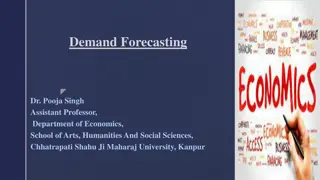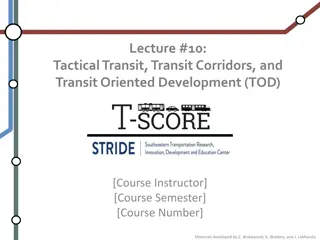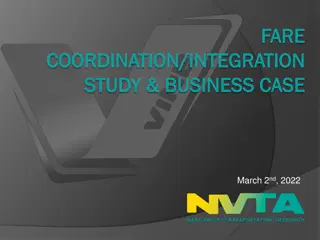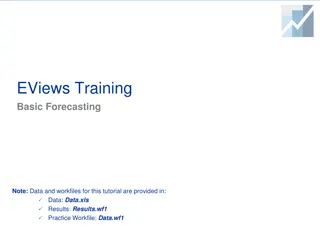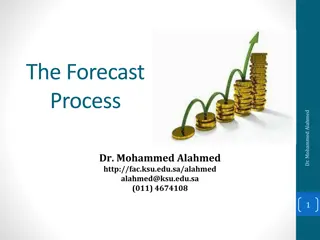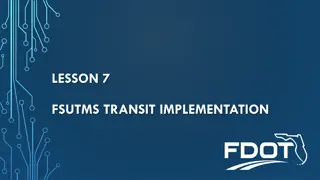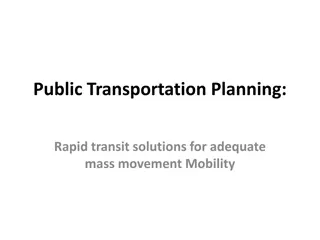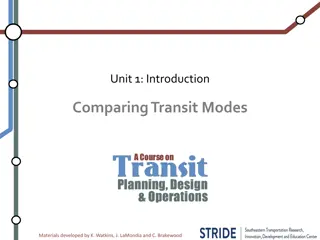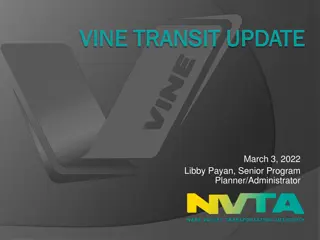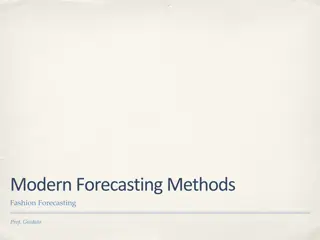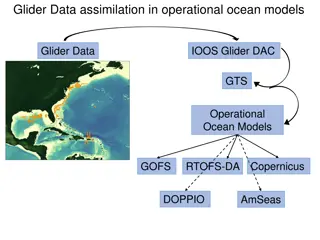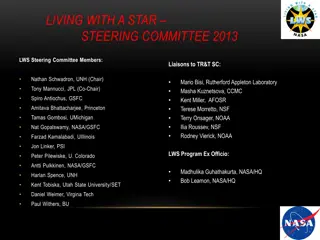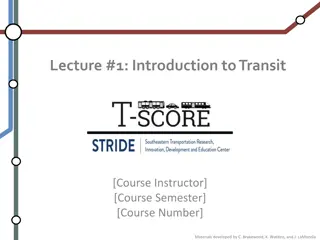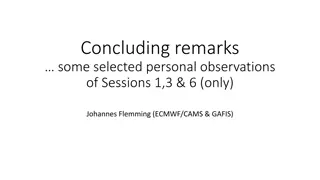Understanding Ridership Forecasting for Transit Systems
Explore the essential concepts of ridership forecasting in transit systems, including methods to predict ridership changes, transit travel behavior, and factors influencing travel choices. Learn how understanding ridership helps in making informed decisions for improving transit operations and planning for the future.
Download Presentation

Please find below an Image/Link to download the presentation.
The content on the website is provided AS IS for your information and personal use only. It may not be sold, licensed, or shared on other websites without obtaining consent from the author. Download presentation by click this link. If you encounter any issues during the download, it is possible that the publisher has removed the file from their server.
E N D
Presentation Transcript
Lecture #17: Ridership Forecasting [Course Instructor] [Course Semester] [Course Number] Materials developed by C. Brakewood, K. Watkins, and J. LaMondia.
Outline Overview of transit demand Methods to forecast ridership changes Transit elasticity values Travel demand models
Goal of Understanding Ridership Tells us which changes are worth the time and monetary investments Helps us anticipate how transit system operations will evolve Improves our planning process for selecting the best alternative
Transit Travel Behavior is defined as: the direct and indirect ways in which patrons use the transit system, including: Number of trips Destinations Activities Trip patterns Timing
General Factors Affecting Travel Behavior Region-level 1. Transport System Context 2. Transit Service Characteristics 3. Transport Policies/ Perception Individual-level
1. Transport System Context Population characteristics Economic conditions Cost & availability of alternative modes Land use & development patterns Travel conditions
2. Transit Service Characteristics Service adjustments/ improvements Partnerships & coordination Marketing, promotion and information initiatives Fare collection & fare structure initiatives
3. Transport Policies/ Perception Price & availability of modes Quality of service of modes Characteristics of desired trips Traveler motivation/ bias
Relationships are not always clear Confounding factors Additional factor that is the cause of behavior but is highly correlated with other factors Lurking factors Additional factor that is the cause of behavior but is missed in analysis
What is the Gas Price Tipping Point? National Transit Database, U.S. Energy Information Administration's Gas Pump Data History, and Bureau of Labor Statistics' Employment Data.
Future is Based on Behavioral Considerations Estimation of future travel behavior is only as accurate as the estimates of future development. Estimates are based on current conditions and behavior; assume people act the same in the future. Estimates are determined by external factors as well as the type of system, so need to consider both. Behavior is inherently individual, so should consider personal preferences/ biases.
Behavior Review Process Collect Information on Past Trends Estimate Future System Changes Predict Future Travel Behavior Develop Relationship Trends
METHODS OF FORECASTING RIDERSHIP CHANGES TCRP Synthesis 66, Chapters 3-4
Data Sources & Inputs Source: TCRP Synthesis 66, page 9
Forecasting Techniques Source: TCRP Synthesis 66, pages 9-10
ELASTICITY CALCULATIONS Victoria Transport Policy Institute: Price Elasticities and Cross-Elasticities
Elasticities Demand sensitivities are measured using elasticities Demand elasticity is the percentage change in the number of riders as a result of a one-percent change in price (or some other factor) Example: Simpson-Curtin rule 3% fare increase reduces ridership by 1%
Elasticity Equation Example: Simpson-Curtin rule, 3% fare increase reduces ridership by 1% Transit Price Elasticity = -0.33
Elastic/ Inelastic Threshold Range from - to + + indicates an increase in ridership due to the 1% factor change - indicates a reduction in ridership due to the 1% factor change <|1| indicates inelasticity, with little impact >|1| indicates elasticity, with high impact Example: Simpson-Curtin rule, Transit Price Elasticity = -0.33 Transit price elasticity is inelastic
Examples of Elasticity Values Litman, Page 7
PARTICIPATION EXERCISE Calculating elasticity values
Additional Reference http://onlinepubs.trb.org/onlinepubs/tcrp/tcrp_rpt_95c1.pdf
Methods for Forecasting Demand Collect Data Describing a Specific Area Predict Total # Travelers Predict % of Transit Riders Predict # Transit Riders Predict # Transit Riders Determine the Total # of Transit Riders per Timeframe
Methods for Forecasting Demand Collect Data Describing a Specific Area Predict Total # Travelers Predict % of Transit Riders Predict # Transit Riders Predict # Transit Riders Determine the Total # of Transit Riders per Timeframe
General Demand Forecasting Process Collect Current/ Past Behavior & Characteristic Data Collect/Project Future Characteristic Data Estimate Relationships Between Characteristics & Behavior (DEMAND MODEL) Apply Demand Model to Future Characteristic Data Predict Future Behavior
Two Approaches System Demand Approach Individual/ Aggregate Route Level Demand Approach Aggregate Large Spatial Scale Typically, a city or region Local Spatial Scale Typically, a route or stop Policy/ Choice Analysis Mode choices Influence on congestion Volume Analysis Stop arrivals Rail system studies Ridership along route
Data Collection System Demand Approach Route Level Demand Approach O-D Survey Route Opinion Survey Region level estimates and assumptions for the future growth Route only estimates and assumptions for future growth
Mode Choice of the Decision Maker n = Decision Maker Choice between J alternatives (j = 1,.., J) Utility n obtains for j is Unj Chooses alternative with MAX utility Choose i if Uni > Unj for all j i
Researcher Researcher does NOT know utility Observes attributes of alternatives (xnj) Characteristics of decision maker (sn) Vnj = V(xnj, sn) for all j
Random Utility Models Unj = Vnj + nj Unj = jXnj + jZnj+ + nj Unj is linear function to determine outcome j for observation n j and j are parameters for outcome j Xnj and Znj are observable characteristics nj is an error term
Types of Discrete Choice Models Binary = 2 choices Multinomial = 3 or more choices Logit GEV Probit Mixed Logit nj
Logit Choice Model A C B
Utility Equation Characteristics of the Trip Maker (income, gender, age, HH size, # cars) Attributes of the Mode (travel time & cost, others)
Utility Variable Types Generic variables multiple utility functions with same parameter Alternative specific variable multiple utility functions with different parameters Alternative specific constants constant for all alternatives but one Socioeconomic variables alternative-specific combination with system variable
Estimation Survey Data On-board transit surveys Revealed and stated preference surveys Software Limdep frequently used Biogeme open-source freeware
Mode Choice Example Auto 8 miles 25 minutes TAZ 1 TAZ 2 Bus 9 miles 45 minutes Costs: Auto operating = $0.18 / mi Parking = $10 Bus = $1.50 Uauto = -0.028 * time (in min) 0.004 * cost (in cents) Ubus = -0.028 * time (in min) 0.004 * cost (in cents) 4.52
Mode Choice Example Uauto Ubus = -0.028*(25) 0.004*[(18*8)+1000] = -0.7 4.576 = -5.276 = -0.028*(45) 0.004*(150) 4.52 = -1.26 0.6 4.52 = -6.38 Pauto = e-5.276 e-5.276 + e-6.38 = 75% Pbus = e-6.38 e-5.276 + e-6.38 = 25%
Mode Choice Example Auto 8 miles 25 minutes TAZ 1 TAZ 2 Bus 9 miles 45 minutes Costs : Auto operating = $0.18 / mi Parking = FREE Bus = $1.50 Uauto = -0.028 * time (in min) 0.004 * cost (in cents) Ubus = -0.028 * time (in min) 0.004 * cost (in cents) 4.52
Mode Choice Example Uauto Ubus = -0.028*(25) 0.004*(18*8) = -0.7 0.576 = -1.276 = -0.028*(45) 0.004*(150) 4.52 = -1.26 0.6 4.52 = -6.38 Pauto = e-1.276 e-1.276 + e-6.38 = 99% Pbus = e-6.38 e-1.276 + e-6.38 = 1%
Independence of Irrelevant Alternatives (IIA) Relative probability of choosing i over j depends only on i and j Strengths Estimated from one choice set and predict from modified choice set No need to include all possible choices Weakness Must be independent alternatives
Red Bus, Blue Bus Car Bus Ucar = Ubus = 1
Red Bus, Blue Bus Car Bus Car Red Bus Blue Bus Ucar = Ubus = 1
Red Bus, Blue Bus Car Bus Car Red Bus Blue Bus Ucar = Ured bus = Ublue bus = 1 Ucar = Ubus = 1
Puget Sound Regional Council (PSRC) Mode Choice Model SOV Drive to Transit Walk HOV2 Bike Walk to Transit HOV3+ See: https://www.psrc.org/sites/default/files/2015psrc-modechoiceautomodels.pdf
PSRC HBW USOV = -0.0253*IVTT 0.0038*Cost1 0.0021Cost2 0.0014Cost3 0.0011*Cost4 + MSP UHOV2 = -0.0253*IVTT 0.0038*Cost1 0.0021Cost2 0.0014Cost3 0.0011*Cost4 + 0.199*CBD 2.355 + MSP UHOV3+ = -0.0253*IVTT 0.0038*Cost1 0.0021Cost2 0.0014Cost3 0.0011*Cost4 - 0.268*CBD 3.968 + MSP UTransitW = -0.0253*IVTT 0.0633*OVTTwalk 0.0506*OVTT7min 0.0038*Cost1 0.0021Cost2 0.0014Cost3 0.0011*Cost4 +0.593*CBD + 0.351 + MSP UBike = -0.1020*Time + 0.173*CBD 1.151 + MSP UWalk = -0.0788*Time + 1.688*CBD + 0.491 + MSP IVTT = in-vehicle travel time; OVTT = out-of-vehicle travel time See ftp://ftp.ci.missoula.mt.us/DEV%20ftp%20files/Transportation/MPO/MODEL_ENHANCEMENT/RFP/Proposals/Cambridge_Systematics/Reference/PSRC.Model%20Doc(final).pdf
Factors Affecting Demand Service-related variables tend to overwhelm demographic and employment factors Fare costs Travel times Wait times Access/ egress distances
Which method for understanding ridership is best? It all depends... How much information do you have? How accurate is your analysis? What is the scale of your analysis? How will it be used?


